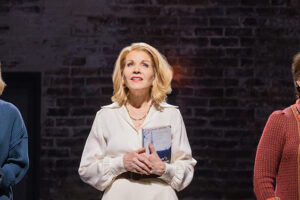

The third in Beaumarchais’ 18th-century trilogy of Figaro plays, “The Guilty Mother” is somewhat gloomier and more overcast than the two comedies preceding it. Its protagonists—the buffoonish Almavivas and their clever servants—appear more subdued in this last installment; its central villain functions more as Tartuffe-inspired homage than as living, breathing adversary.
Perhaps for these reasons, as of today, “Mother” remains the least revived of the three Spanish farces. Certainly as source material for an opera, it hasn’t had much of an afterlife, either.
Still, none of these concerns kept Milhaud, a well-traveled, Brazil-loving member of the Les Six group of interwar French composers, from setting the piece to music in 1965. While the results of his experiment were mixed and never received the same acclaim as his boisterous earlier compositions, “Guilty Mother” presents several neoclassical shake ups, chief among them dialogue that is almost entirely polytonal.
Yesterday, cub company On Site Opera gave this rare opus its American premiere, kicking off a three-night run with an immersive, chamber-scale production at the midtown-west industrial space The Garage. Artistic director Eric Einhorn’s revival is meant to coincide with the composer’s 125th birthday, but it also wraps up On Site’s valiant quest to present lesser-known adaptations of the three Figaro plays.
From their folding chairs in the middle of the show’s open, garage-sized set, spectators were ultimately treated to an ambitious production, compellingly staged but visually clumsy, that made the opera more palatable yet did little to overcome its considerable flaws.
La Mère Coupable takes up two decades after “The Marriage of Figaro.” The Count Almaviva (Adam Cannedy) and his wife The Countess (Jennifer Black) have grown increasingly debased; they have also each produced an illegitimate child, Florestine (Amy Owens) and Léon (Andrew Owens), respectively, who happen to be in love.
As the Count’s valet Figaro (Marcus DeLoach) remarks, “Thieves often weasel their way into a house like this.” And indeed, a weaselly Irishman named Bégearss (Matthew Burns) has nearly succeeded in screwing the Count and Countess out of their fortune. This leaves Figaro and his wife Suzanne (Marie Lenormand) to rectify things as usual. And save the day they do—well, sort of. (“We have all done our duty,” the ensemble declares in self-satisfied French.)
Located just off the West Side Highway, The Garage proved an unlikely spot for an opera: it’s a bit of an echo chamber. But Einhorn and scenographer Cameron Anderson committed themselves to capturing the dim ambiance of an estate in decline, and made some inventive use of the space.
For each act, the audience sat facing a different direction—toward the back of the house, then rotating to the front. In act one, the minimalist set consisted of two sparsely decorated rooms strewn with flower petals, cardboard boxes, worn rugs, and cloth-covered chairs, and lots and lots of pill bottles near the Countess’ trundle bed. Act two brought us to a dining room, with a shabby-chic table primed for a dysfunctional dinner.
In fact, the look of the entire production was stylishly boho, though to sometimes jumbled effect. Costumes by designer Beth Goldenberg were a dapper gallery party of blacks and grays, turtlenecks, jean jackets, and designer loafers. (Here, Bégearss is aloof and metrosexual, a bespectacled Stanley Tucci type taking prissy pains to con the whole family.) But with metro partying comes the occasional lack of focus: many of us had to crane in order to see supertitles, which were awkwardly projected to the side of the stage.
Conductor Geoffrey McDonald led his expert orchestra, recruited members of the top-shelf International Contemporary Ensemble, from the middle of the warehouse, so the music came from behind the audience in both acts. This placement threw the score’s driving sound a bit out of focus as well—Milhaud’s tonal language of the Sixties is still flavored with jazz idioms, but also features a firm, stony neoclassicism that would have been nice to see played, and not to our rears—as though the work’s discordant harmonies were being tooted from right out of the audience.
Einhorn’s staging snakes the actors in and through the spectators, a choice that had the adverse effect of causing a lot of running around when Milhaud is aiming, albeit to various degrees of success, to plumb the characters’ interiorities. All the commotion put a strain on some of the vocalizing as well—Cannedy sounding slightly winded at the top of his range as the Count; Black’s gorgeous, syrupy soprano occasionally losing grip on diction—and stole attention from the production’s other benchmark performances.
As the servants, Gallic mezzo-soprano Lenormand (already a legend at l’Opéra comique de Paris and co-recipient of a 2015 Grammy for best opera recording) and veteran baritone DeLoach both elevated the music to its full sonorous potential. Burns was a smooth Bégearss who didn’t sound quite menacing enough, but his bass-baritone was nicely shaded and well produced on opening night.
An announcement at intermission reassured us that the reason we couldn’t hear any of tenor Andrew Owens as Léon had to do with his seasonal allergies—what a shame, as his acting was fresh and full of earnest vim. Amy Owens’ Florestine was a fetching blonde ingenue with a gleaming coloratura; I look forward to hearing what else she can bring to new music, though she’ll be singing Verdi in Livermore Valley Opera’s Ballo in maschera next year.
Milhaud’s eccentricities as a composer are on full display in this opera. But the work’s great oversight, in my view, has to do with its obstinate lack of relief from all the dramatic tensions it furnishes. With the exception of an animated march ending act one, there is relatively little in the score to offset the doom and gloom, so the audience is left feeling a bit spent by the climax, regardless of the plot’s happy ending. But then, even that ending is served with a sly, cynical little wink: I suppose in the world of this production, no merry resolution is truly guilt-free.
Photo: Fay Fox























Comments